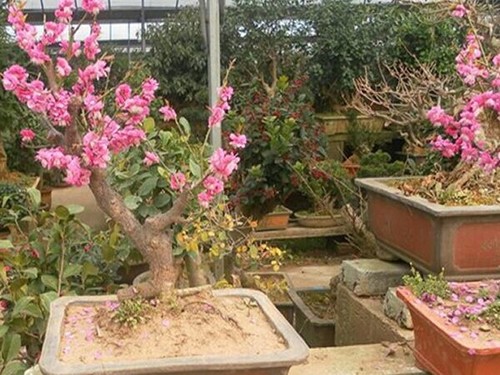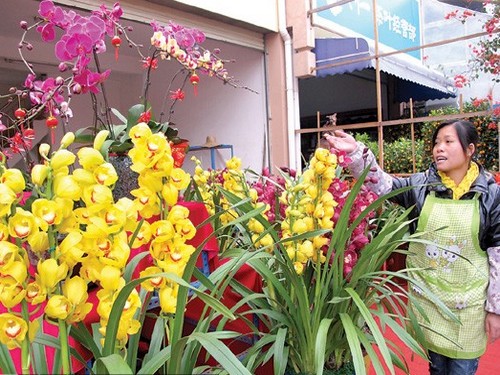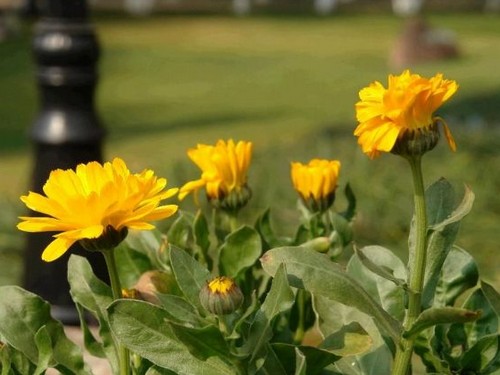Culture methods and matters needing attention of Prunus mandshurica
It is widely used in Beijing gardens to reflect the prosperity of beautiful spring and flowers. Should be planted in the park grass, roadside, or garden in the corner, pool, and so on. If the elm leaf plum is planted in front of evergreen trees, or planted in the mountains and rocks, it can produce a good ornamental effect. Planted with Forsythia suspensa, it is more spring when it is in full bloom with red and yellow.

Elm leaf plum is a widely planted flowering tree species in northern China, with dense branches and leaves, colorful flowers and colors, if you cooperate with other plants to watch the effect is very good, the following editor to everyone to understand the cultivation methods of elm leaf plum:
The culture method of elm leaf plum:
1. Soil: the requirement of soil is not strict, but it is not resistant to waterlogging and prefers neutral to slightly alkaline, fertile and loose sandy loam.
2. Temperature: like the warm climate, but the hot and muggy environment in summer is not conducive to its growth; the temperature in winter is very strict, when the ambient temperature stops growing below 10 ℃, it can not survive the winter safely under frost.
3. Sunshine: sufficient sunshine can be given in autumn, winter and spring. When keeping it indoors, try to put it in places with bright light, such as well-lit living room, bedroom, study and so on.
4, watering: avoid waterlogging, planting in spring, if the weather is dry, water 2-3 times, usually no watering, at the same time, pay attention to rainy season drainage.
5. Pruning: pay attention to pruning branches in the process of growth. After the flower fade, cut the flower branches moderately, leaving 3-5 buds on each strong branch. After falling in, prune again, and top and pick the heart, so that the nutrients are concentrated and the flower buds germinate.
6. Insect pests: the main diseases and insect pests of Prunus mandshurica are brown spot, white feather, aphids, stinging moths, red spiders, leaf rollers and so on, which generally occur in summer and autumn, so they should be sprayed and controlled in time.
Elm leaf plum is widely planted, and it is a good ornamental flower and tree. if it cooperates with forsythia, pine and cypress all the time, the ornamental effect will be better.
If you want to plant a good elm leaf plum, so that it can blossom more, we must pay attention to the following points.
The main results are as follows: (1) planting elm leaf plum should be carried out in spring and autumn. When planting, the hole should be filled with rotten base fertilizer and watered thoroughly after planting. Water should be watered 2-3 times every spring, usually without watering, and pay attention to waterlogging in the rainy season at the same time. Topdressing can be applied once or twice a year from May to June to promote plant differentiation of flower buds.
(2) in the process of growth, attention should be paid to pruning branches. After the flower fade, the flower branches can be cut moderately, leaving 3-5 buds on each strong branch. After falling in, prune again, and top and pick the heart, so that nutrients are concentrated and flower buds germinate. Liquid fertilizer can be applied once after pruning. Usually, it is necessary to remove the miscellaneous leather in time to facilitate the healthy growth of the plant. For potted elm leaf plum, pruning should be carried out in time to control the overgrowth of plants. After flowering in June, in addition to pruning the branches, it is also necessary to bind and bend the branches so as to restrain the tip growth advantage.
Time: 2019-06-01 Click:
- Prev

Culture methods of potted Cymbidium
The place where the cymbidium is placed is very important, which directly affects the growth and development of the orchid. Cymbidium is usually placed in the open field in spring, summer and autumn (in summer in the shade of the open field) and indoors in winter. It is best to be open and moist outside. There should be plenty of light in the room, preferably facing south. Like this
- Next

Culture method of calendula (Calendula)
Calendula, also known as marigold, is a plant of the genus Calendula in Compositae. It is often used in flower beds and is native to southern Europe. Calendula is one of the common flower plants with bright colors. It is not uncommon for potted plants to decorate homes. It is suitable for flower beds and flower belts, and can also be used as lawn border flowers or potted plants to watch.
Related
- Fuxing push coffee new agricultural production and marketing class: lack of small-scale processing plants
- Jujube rice field leisure farm deep ploughing Yilan for five years to create a space for organic food and play
- Nongyu Farm-A trial of organic papaya for brave women with advanced technology
- Four points for attention in the prevention and control of diseases and insect pests of edible fungi
- How to add nutrient solution to Edible Fungi
- Is there any good way to control edible fungus mites?
- Open Inoculation Technology of Edible Fungi
- Is there any clever way to use fertilizer for edible fungus in winter?
- What agents are used to kill the pathogens of edible fungi in the mushroom shed?
- Rapid drying of Edible Fungi

